|
1.
CENTRAL/ WEST AFRICA
Gabon log export scheme
It is reported that the Government of Gabon will now
implement a gradual phasing out of log exports.
It appears that those logs cut up to 31st December 2009
can be exported through SNBG until end of April. This is
a month later than originally intended.
Trade sources say that in view of the large volumes of logs
already on the ground (somewhere between 500,000 cubic
metres and 700,000 cubic metres), it is unlikely that all
can be exported before the end of April and that a new cutoff
date may be set when the actual volumes to be shipped
are known.
The logistics involved in transporting, loading and
shipping such a large volume are enormous. As the trade
points out, there may not be enough trucks or rail carts to
handle such a volume quickly. It is reported that most of
the volume has been forward purchased by buyers for the
Chinese market.
After the 30th April 2010 deadline (or a revised date) a
quota scheme will be introduced.
Phased log exports up to 2012
At present, it seems that for the balance of 2010, the
maximum harvest volume will be set at 1.2 million cubic
metres of which 60% must be processed domestically. If
this is achieved, then the balance 40% could be exported
as logs.
The 2011 total harvest will be set at 1 million cubic metres
of which 75% has to be processed locally before the
balance 25% can be exported as logs.
In 2012, the plan, at present, is for a total harvest of
800,000 cubic metres of which 80% must be processed
domestically before the balance can be exported as logs.
Assessing processing capacity
Forestry authorities in Gabon are currently assessing the
processing capacity of established mills in the country.
This is to determine if they have sufficient capacity to
carry out processing of the required percentage of their
harvest volume.
The log harvest quota allocated to each mill will be based
on the assessment of the mill capacity.
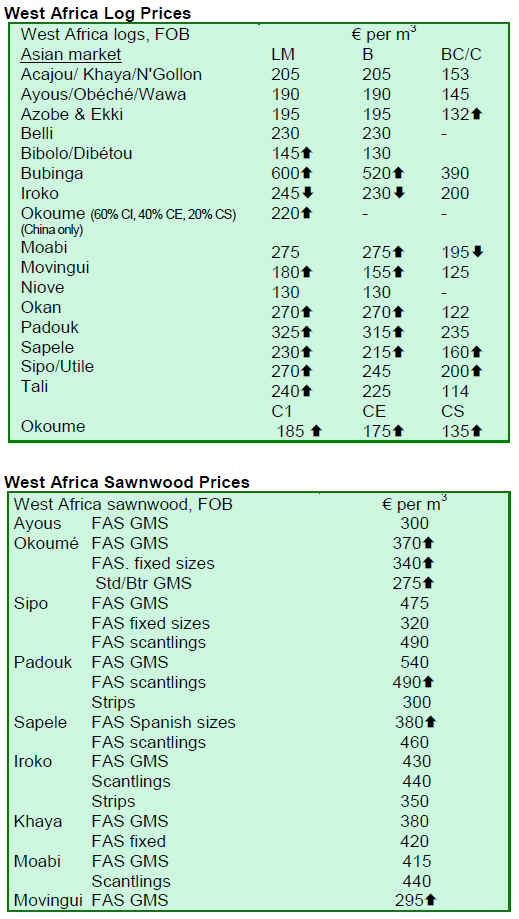
2. GHANA
Privatisation of SIPL
As part of its programme to privatise state owned
enterprises, the Government of Ghana has invited
proposals and bids for the privatisation of Subri Industrial
Plantation Ltd (SIPL).
Established in 1985, SIPL established Gmelina arborea
plantations intended to feed a proposed pulp and paper
mill at Daboase in the Western Region of Ghana. The pulp
and paper mill has not been built but a sawmill and wood
processing facilities were installed to utilise the Gmelina.
The location of the processing plant is 40 kilometres from
Sekondi/Takoradi, the regional capital and the Western
seaport of Ghana.
SIPL has a nursery and 5,137 hectares of plantations with
about 13,000 hectares of underdeveloped forest land for
plantation expansion. SIPL has a sawmill and kilns and
produces value-added products as well as lumber.
Lumber dominates export trade
The TIDD vetted, processed, and approved 2,468 export
permits during the fourth quarter of 2009 covering
shipment of various timber and wood products through the
ports of Takoradi and Tema as well as for overland
exports to neighbouring ECOWAS countries.
Compared to the previous quarter, fourth quarter approvals
fell by 13%. However, when data for the quarter under
review are compared with the corresponding figure for the
same period in 2008, there was a substantial increase in
the number of approvals in the fourth quarter of 2009.
Lumber (both air dried and kiln dried) continues to
account for the highest number of export permit
applications. This is an indication that there is still a higher
demand for export lumber than for tertiary wood products
such as furniture and parts, mouldings, flooring, dowels
and profiled boards.
Inflation falling
Ghana¡¯s inflation continues to fall, dropping by 0.55
percentage points to 14% in February 2010. This is the
second decline recorded since January and the eighth since
June 2009.
The Ghana Statistical Service which announced the rate
attributed the drop to a stable Cedi and a drop in the
demand for goods and services. The Head of the
Economic Statistical Service, Ebo Duncan, announced that
inflation might continue to fall if the government
continues with its stabilisation programmes and fiscal
discipline. The current rate is the lowest in 23 months,
Central Bank figures show.
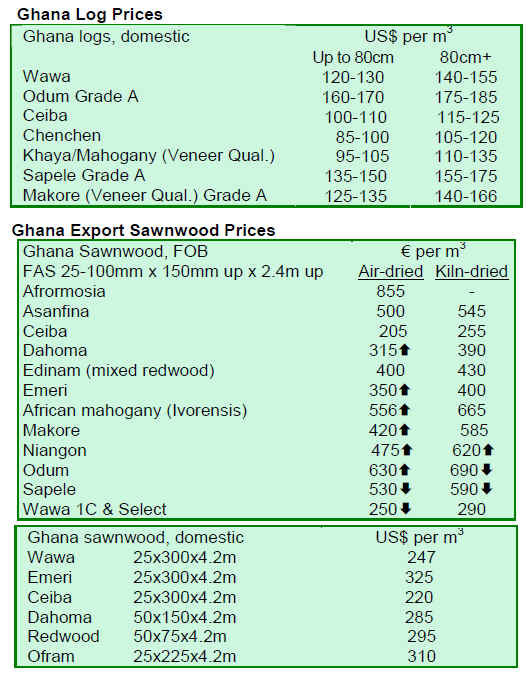
3.
MALAYSIA
One-stop buy-sell event
The Malaysian Timber Council (MTC) will host its first
international one-stop selling, buying and networking
event, ¡®MTC Global Woodmart 2010¡¯ on October 19-20,
2010 at the Kuala Lumpur Convention Centre.
This event will showcase tropical timbers as well as those
from temperate regions. The event is also to provide a
venue for buyers and sellers of timber products to meet,
network and to conduct business under one roof. This type
of event may be the first of its kind in South-East Asia and
MTC plan to host this event every two years.
On display will be a wide range of new products, or socalled
¡®Innovative Products,¡¯ for example bio-composite
boards derived from oil palm trucks, kenaf and rice husk.
Trans-Pacific Partnership
The US Ambassador to Malaysia has expressed the hope
that Malaysia will join the Trans Pacific Partnership (TPP)
to take advantage of the expected increased trade volume
and improved access to US markets. The TPP is also
expected to increase trade flows and market access
between all member countries.
Currently, the TPP consists of eight countries; Brunei,
Chile, New Zealand, Singapore, Australia, Peru, Vietnam
and the US.
The ambassador added that it would be difficult for
Malaysia to join the TPP once the other eight member
countries have agreed the TPP trade pact. With this in
mind Malaysian trade officials are reportedly evaluating
the advantages and disadvantages of the TPP before
considering negotiating with the other countries.
Singapore¡¯s furniture exports dip
Many Malaysian furniture manufacturers have business
relations with companies in Singapore. Singapore¡¯s
furniture exports declined 4% in 2009 compared to 2008
exports. For 2009, exports were worth a total of S$4.7
billion while 2008¡¯s exports were worth S$4.9 billion.
Singapore¡¯s share of the world furniture market continues
to drop and currently is less than 1%.
Efforts by the Singaporean Government, through agencies
such as IE Singapore and SPRING Singapore, has helped
Singaporean furniture manufacturers and companies to
network and link up with more than 1,200 new furniture
buyers from Russia, Mexico, India and the US.
Building activity encourages industry
With the spring construction season in high gear in China,
Malaysian timber products manufacturers believe that the
recent crisis is over. Although the Chinese government is
making efforts to cool its housing market, there is still a
strong demand for Malaysian timber products for the
Chinese market.
Rent levels in China are expected to decline marginally in
most major Chinese cities as more homes come onto the
market. However, those who have invested in the buy-tolet
sector are beginning to renovate and remodel
properties in their portfolio in order to gain higher rental
income in the housing for expatriates market.
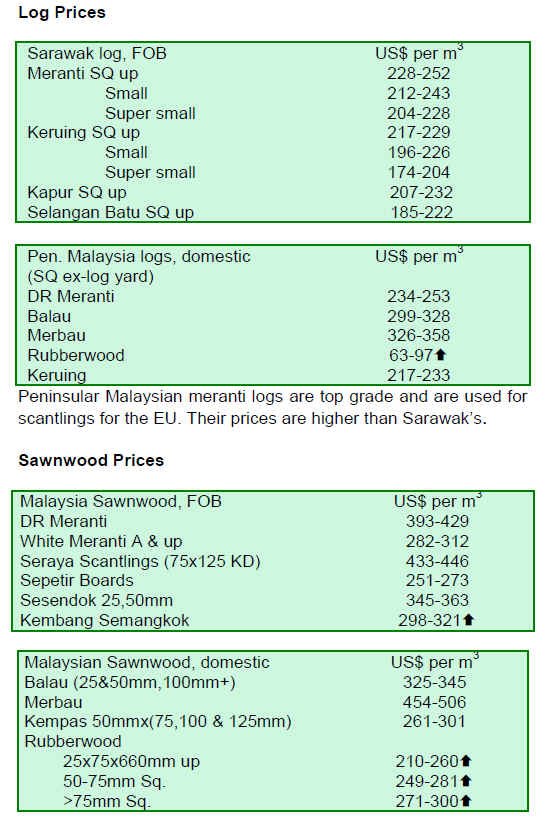
4.
INDONESIA
Ready to compete with China
The Indonesian Furniture Entrepreneurs Association
(ASMINDO) has reportedly expressed optimism that its
members are ready to compete with China for the
Indonesian domestic furniture market.
The chairman of ASMINDO claimed that the Chinese
suppliers will be seeking a US$500 million share of the
local furniture market and that some US$250 million to
US$300 million could be captured by Indonesian
furniture manufacturers. Plans are being prepared by
ASMINDO to ensure Indonesian manufacturers capture a
market share of US$600 million.
ASMINDO will be hosting a SMEESCO (Small and
Medium Enterprises and Cooperatives) exhibition in June
2010, to promote Indonesian furniture and accessories to
the Indonesian public sector as well as to local real estate
developers. In addition, Indonesian furniture
manufacturers will participate in an exhibition in Shanghai
this year over a floor space of 1,600m2.
Hint of furniture export recovery
ASMINDO has reported that Indonesian furniture
exporters have, over the past few months, experienced a
recovery in exports after the plunge experienced in 2009.
Indonesia¡¯s furniture exports stood at US$2.35 billion in
2009 compared to US$2.65 billion in 2008. In January
2010, exports rose by 16% compared to levels in January
2009.
The US and EU remain the main markets for Indonesian
furniture exports accounting for 35% and 30% of total
exports respectively.
ASMINDO is hopeful that Indonesia¡¯s furniture exports
will increase by 15% to 20% this year.
Furniture and craft fair
The 3rd International Furniture and Craft Fair is currently
being held at the Jakarta International Expo, in Central
Jakarta. ASMINDO is projecting business deals worth up
to US$250 million will be achieved, an increase over the
US$170 million transacted in 2009. A record number of
buyers (up to 2,500) are expected to attend this year
compared to 1,721 buyers registered last year.
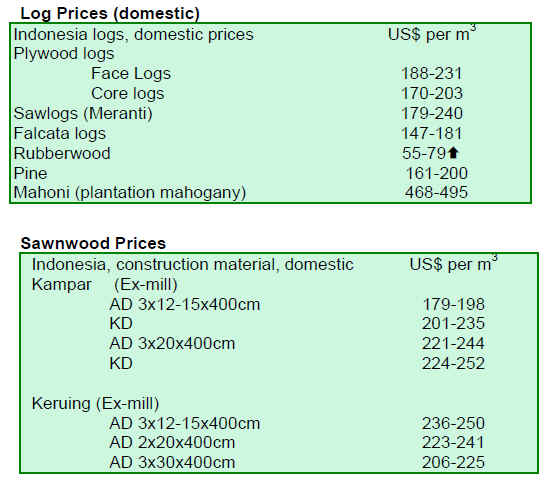
5.
MYANMAR
Market Outlook
Demand for teak and pyinkado, as determined from
buyer¡¯s interest at the monthly auctions, remains steady.
The pre-New Year celebrations for Myanmar are always
an active time in the timber industry.
Extra quantities of freshly felled logs will be delivered to
the log depots before the onset of the rain season.
The Myanmar New Year (Thin-gyan festival) falls in
April and government offices and private companies will
cease activities for about 17 days during the month and
there is virtually no business activity during that time.
Reduced log harvests
¡®The Voice¡¯, a weekly journal in Myanmar has reported
on the speeches made by U Sein Lwin, Chairman of the
Timber Merchants Association (TMA) and U Aung Lwin,
Vice Chairman of the Union of Myanmar Chamber of
Commerce and Industry (UMFCCI) at the annual meeting
of the association.
U Sein Lwin of the TMA mentioned the government plan
to reduce log production beginning in April. Whilst the
association was not informed of the level of reduction
being proposed, he said they were aware of the plan which
aims to reduce log harvests and reduce sales of timber in
log form.
U Aung Lwin of the UMFCCI reported that Myanmar
exported 600,000 tons of various timbers in the financial
year 2008-09. Most of this was exported either as logs or
semi finished products and earned only about US$ 400
million. Revenues could be much higher he said if
processed products were exported. He urged the local
entrepreneurs to produce more valued added products.
U Aung Lwin also mentioned that revenue from the
forestry and timber sectors has been falling year by year.
The decline started in 2003 as a result of the imposition of
sanctions by the US and was made worse by sanctions
imposed by the EU in 2007.
The recession in 2008 also disrupted the Myanmar timber
trade and U Aung Lwin expressed optimism in the current
global economic recovery.
Deforestation update
Although, at present, there has been no confirmation of the
plan to reduce log production from the Myanmar Timber
Enterprise, analysts say the plan to reduce log production
is a wise measure to combat deforestation.
It was reported by the Forest Department (FD) that the
annual deforestation rate between 1975 to 1989 was
0.64%; and from 1989 to 1998 it was 1.2% (the latest
estimates available).
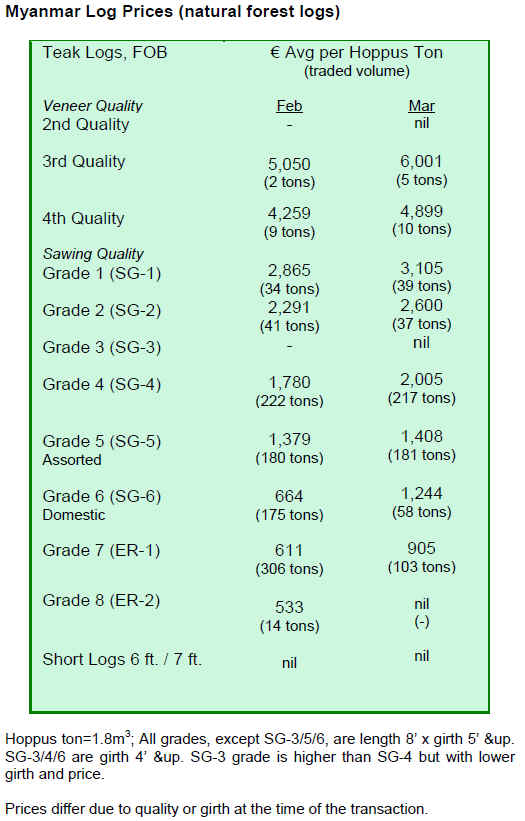
Teak auction prices have increased. Buyers for the Thai
market were active this month and Singapore based buyers
for the Indian market were also keen buyers this month.
6. INDIA
A memorable decade of growth
The Economic Advisory Council Chairman
Mr.C.Rangarajan, sees growth prospects for the Indian
economy being maintained through stable fiscal and
monetary policies. He expects GDP growth to be 8.2%
over the next fiscal year.
The 2000-2010 decade is proving a memorable decade of
progress during which, in spite of global upheavals in
2008/9, India has continued strong growth. Additionally
the publicity surrounding the Climate Summit in
Copenhagen raised environmental awareness in India and
has given fillip to official efforts on environmental issues.
India¡¯s wood working industries have also started to think
¡®green¡¯ and the country¡¯s Compensation Afforestation
Programme, under which any change of use of public
forests to non-forestry purpose is compensated for through
afforestation of degraded or non-forested land, has
received accolades from UNEP.
Local hardwood auctions
Auction sales in Gujarat were delayed due to public
holidays during the month. It is expected that the next
series of sales will be announced in the first week of April.
In the central India log depots around 6000 cubic metres
were sold last month. Local demand was very much
apparent but many lots were not up to the usual quality
and realised lower prices than previously attained. Prices
remained firm for good quality logs. The average prices at
the latest auction are as follows:
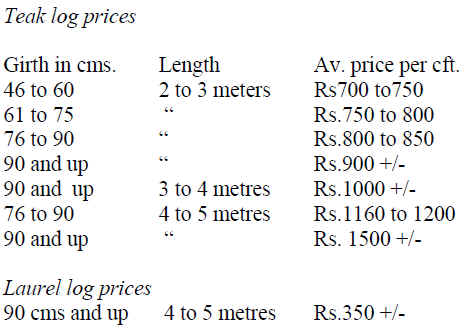
Prices for imported logs
Current C&F rates for containerised plantation teak logs
and rough squares are given below. Freight rates have
been rising and there has been some upward revisions of
prices already, but not in all cases. Market demand is
steady and flow of exports from the supply countries is
reported as satisfactory.
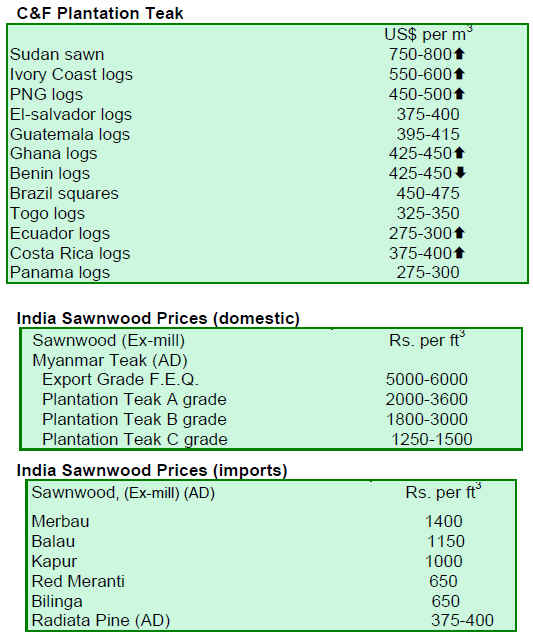
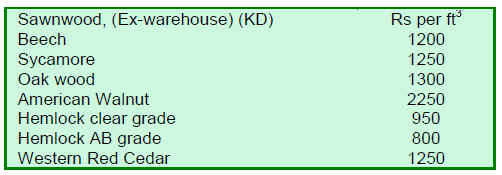
7. BRAZIL
Export performance
In February 2010, exports of wood products (except pulp
and paper) increased 0.5% compared with values for
February 2009, from USD 184.2 million to USD 185.1
million.
Pine sawnwood exports fell 21% in value in February
2010 compared to the same month of 2009, from USD
11.8 million to USD 9.3 million. In terms of volume,
wood product exports fell 23.5% from 59,700 cubic
metres to 45,700 cubic metres over the period.
Exports of tropical sawnwood decreased in terms of both
volume and value, from 43,600 cubic metres in February
2009 to 38,100 cubic metres in February 2010, and from
USD 20.4 million to USD 19.7 million, respectively over
the same period. These correspond to a 12.6% decline in
volume and 3.4% decline in value.
Pine plywood exports dropped 5% in value in February
2010 compared to the same period of 2009, from USD
24.7 million to USD 23.5 million. The volume exported
fell 25% during the same period, from 96,000 cubic metres
to 71,800 cubic metres.
Similarly, exports of tropical plywood were down from
11,000 cubic metres in February 2009 to 7,900 cubic
metres in February 2010, representing a 28% fall. In value
terms, a 26% reduction was recorded over the period, from
USD 6.1 million to USD 4.5 million. Wooden furniture
exports were up from US$ 41.6 million achieved in
February 2009 to USD 43.6 million in February 2010,
representing a 5% increase.
Economic overview
According to the Brazilian Institute of Geography and
Statistics (IBGE), the Consumer Price Index (IPCA) for
February 2010 increased 0.78%, slightly above the rate
0.75% recorded in January.
To-date, the accumulated inflation rate for the year is
1.54%, above the overrun of 1.03% in the same period in
2009. The IPCA of February 2009 was 0.55%.
In February 2010, the average exchange rate was BRL
1.84/USD, while the rate was BRL 2.31/USD in the same
month of 2009 illustrating the appreciation of the Brazilian
currency against the US currency over the period.
The Monetary Policy Committee (Copom) of the Brazilian
Central Bank (BC) has held interest rates unchanged at
8.75% per year. Interest rates in Brazil have not changed
since July 23, 2009., According to a survey carried out by
the BC, the financial markets are anticipating an interest
hike from April and that rates may climb to 11.25% by
year end.
State forests under-utilised
State owned forests in the Amazon, considered as the
cornerstone of the government¡¯s plan to promote
sustainable economic development in the Amazon, are still
under utilized.
In 2006 it was expected that concessions over some 13
mil. hectares would be offered over a 10 year period but,
to-date, concessions covering only 96,000 hectares have
been processed by the government.
The delay, according to reports was due to the fact that
¡°original plans for the concessions did not consider some
key procedural elements,¡± such as the need for public
consultations, management plans and environmental
permits.
It has been estimated that around US$1.8 bil. could be
generated annually if the planned concession bidding and
allocation was fully implemented. The add-on value to the
economy would be considerable when harvesting and
processing activities are factored in.
Media reports suggest that, in the first half of 2010, the
Brazilian Forest Service (SFB) may grant timber
concessions over a further 700,000 hectares.
Certified timber exports
The Northern Amazonian state of Acre is a model region
in terms of producing and exporting certified timber
products. As a result companies in the state have become
major wood exporters to Europe, Asia and the United
States. The global economic crisis hit the Acre industries
hard and shipments to the US and EU have dropped
dramatically and put the industry at risk.
SINDUSMAD (the Timber Industries Union of State of
Acre) has prepared a strategy for the timber industry
sector. The development of this strategy was aided by
FIEAC (Acre Industries Federation), to which the union is
affiliated. This strategy identifies two main initiatives: the
need for companies to achieve forest certification and the
implementation of studies to identify the means to achieve
efficient harvesting and forest sustainability in the
Amazon.
Brazil nut wood mill shut
An illegal sawmill dealing with Brazil nut wood was shut
down after inspection, according to the Brazilian Institute
for Environment and Renewable Natural Resources
(IBAMA). The timber company was located in the region
of Itupiranga, southeast of Par¨¢ and had been operating
without environmental permit.
A total of nearly 100 cubic metres of sawnwood and 182
cubic metres of logs were seized. The sawmill, which is
being dismantled, was established in a remote location on
a secondary road along the Trans-Amazon Highway.
IBAMA inspectors believe that the timber company has
processed thousands of Brazil nut trees based on the
amount of wood residues accumulated at the mill.
The harvesting and trade in Brazil nut trees is totally
prohibited because the species is threatened with
extinction. The conservation of this species is especially
important to the people of the region who rely on
harvesting the nut for sale.
Domestic pricing
Domestic prices in BRL, remained stable over the month
but in terms of US$ prices are down slightly due to the
moderate appreciation of the US$ against the BRL.
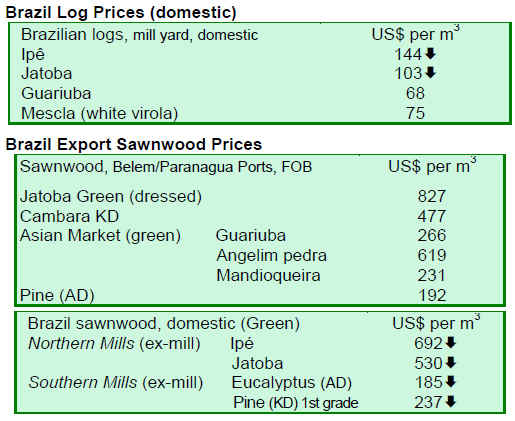
8.
PERU
New law in April
The new Forestry and Wildlife Law that is required
to fulfill the commitments of the Free Trade
Agreement between Peru and the United States will
be sent to Congress in April, according to the Deputy
Minister of Strategic Development and Natural
Resources, Rosario G¨®mez. Ms G¨®mez also said the
ministries of Agriculture and Foreign Trade and
Tourism and the Agency for Supervision of Forest
Resources and Wildlife are working to coordinate the
development of the initiative.
She stated that, currently, the comments and inputs
from stakeholders, especially in the Amazonian
communities, are being incorporated and that the first
draft should be available by the end of March.
No sign of demand recovery
Peru¡¯s timber exports were hard hit by the
international economic crisis in 2009 and recovery is
slow. January exports dropped 3% to US$ 9.39
billion, the second lowest in the past 48 months,
according to the Association of Exporters (ADEX).
The poorest export performance over the past four
years was in January 2006 (US$8.56 million) from
that date until late 2008, exports grew but this
changed in 2009 when the international financial
crisis affected the Peruvian timber sector.
The export figures for January 2010 do not yet
provide a glimpse of the long-awaited recovery.
In January the three main export products were short
boards for parquet manufacture, plywood and lumber.
The view of the president of the ADEX Timber
Committee, Juan Pablo Feijoo, is that this situation
may improve as the new Forestry Law will open new
market opportunities and generate thousands of new
jobs. He added that the implementation of the new
Forestry Law should result in greater timber exports.
Major markets in 2009
China remains the number one market for wood
products from Peru, accounting for around half of all
exports in 2009. The US market accounted for some
17% of total wood product exports in the same year.
Other major markets are Mexico, Dominican
Republic, Australia and Canada.
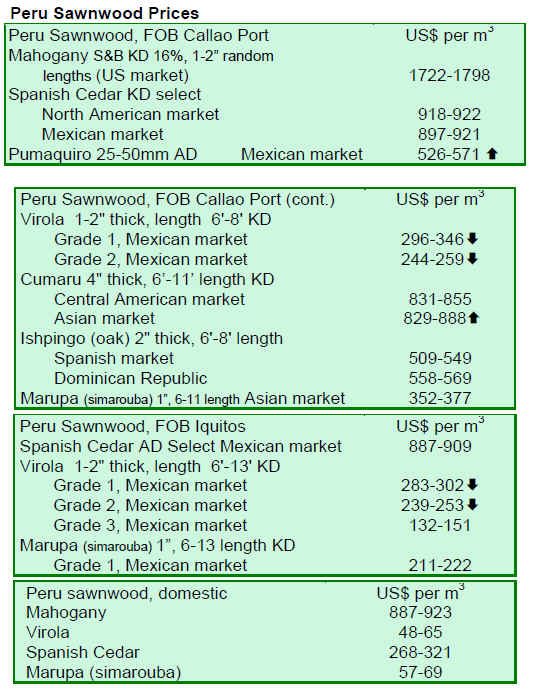
9.
Guyana
During the period under review prices for logs remained
largely unchanged except for Purpleheart small sawmill
quality logs for which prices reached as high as US$200
per cubic metre. Also, Mora standard and small sawmill
quality logs saw price increases.
For this fortnight period, prices for rough sawn
(undressed) Greenheart sawnwood category increased for
both prime and merchantable qualities. At the same time,
Purpleheart (select quality) also recorded increased prices.
Mora sawnwood prices remain stable.
In addition, average prices for both dressed Greenheart
and dressed Purpleheart improved, reaching as high as
US$1,050. Prices for Guyana¡¯s Washiba (Ipe) rough sawn
(undressed) lumber also increased, peaking at US$ 1,600.
Baromalli plywood prices for both BB/CC and Utility
categories remain relatively stable. Splitwood has shown
improvement in average prices and a high of US$ 1,000
per cubic metre was recorded. This product is exported
mainly to the Caribbean countries.
Community Logging Associations
Since 2001 the Guyana Forestry Commission (GFC) has
been facilitating the formation of Community Logging
Associations. There are approximately forty-three active
groups operating seventy six State Forest Permits over a
total area of over 300,000 ha.
These associations have been established for the purpose
of assisting communities that rely heavily on forests as
their main source of livelihood, to gain legal access to
forest resources.
The associations effect change and development within the
community. Activities undertaken help to reduce poverty
and provide alternative sources of economic livelihoods.
The groups create jobs for residents with the aim of
reducing migration from the area and increasing
employment within the community. They also encourage
sustainable forestry practices by securing concessions and
operating according to guidelines set by the GFC.
Initiatives undertaken by the GFC for the associations
include training, granting of scholarships and job offers.
The GFC gets involved in the management and the
issuance of concessions and has raised awareness on the
key areas such as the Code of Practice for Timber
Harvesting, Forest Policies and Law and Reduced Impact
Logging.
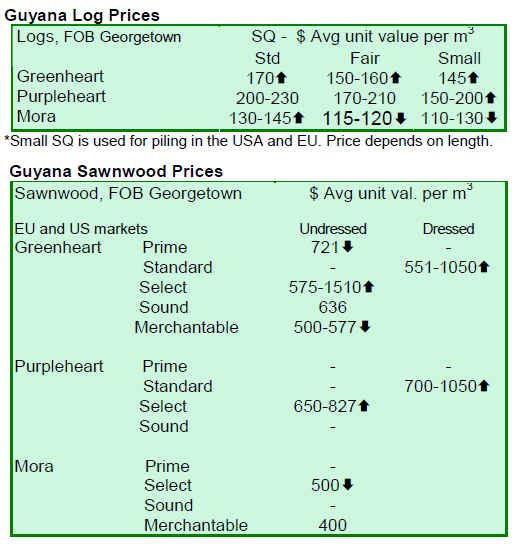
|